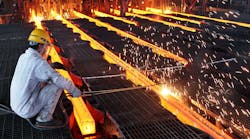As U.S. President Donald Trump mulls sweeping trade policies to defend American producers from a world awash with steel, falling exports from top supplier China point to a glut that’s already shrinking.
Overseas sales of steel over the first six months of the year dropped 28% to 41 million metric tons, according to customs data Thursday. That’s the lowest half-year volume since the first six months of 2014, prior to an unprecedented export surge that roiled global steel markets and triggered dozens of trade suits worldwide. The Trump administration has pledged stringent new measures to protect U.S. producers against overseas rivals.
China, maker of about half the world’s steel, is exporting a lot less of the metal as government-ordered closures of illegal plants tighten supply and improving local demand spurs mills to sell more at home. The nation’s steel industry has reversed course at least for now, buoyed by economic stimulus, capacity shutdowns and speculative interest in the metal. Futures on reinforcement bar, a benchmark product used in construction, have rallied 27% in Shanghai this year and are at a three-and-a-half year high.
Trade Barriers
In recent years, China has drawn scrutiny for excessive production, soaring exports, and sinking prices. Last week’s Group of 20 meeting in Germany saw global steel overcapacity high on the agenda as the Trump administration weighs punitive tariffs to protect the American Rust Belt. Steelmakers from Japan to Canada are awaiting the outcome of a U.S. Commerce Department probe on whether foreign steel threatens national security, with the decision likely to shape how Trump targets imports.
Trade measures already in place worldwide that target China have crimped the nation’s ability to ship overseas. But it’s mostly domestic policy that’s responsible for the fall in exports, with millions of tons of basic construction steel capacity shut down by the government, amid a credit-and-infrastructure binge that’s supported demand. Net exports could fall to 50 million tons next year, according to Goldman Sachs Group Inc.
“Lower exports are due to strong demand domestically and also prices, so producers don’t have the motivation to export,” Yi Zhu, an analyst with Bloomberg Intelligence, said ahead of the data’s release. Zhu said she’s just returned from a tour of mills in China, where there are indications of a shortage of some steel products, leaving little room for foreign sales. In June, exports fell to 6.81 million tons, from 10.94 million tons a year earlier.
Aluminum is a Different Story
China’s shrinking steel exports contrast with aluminum shipments, which rose 21% in June from a year earlier to 460,000 tons, and equaling May’s highest volume since 2013. Over the first six months, volumes increased 5.9% to 2.41 million tons. Prices, which have climbed 12% in London this year, have helped spur an expansion in output that may be reined in if the government goes ahead with plans to shut unapproved plants or limit output in the winter months.
Robust steel demand is boosting China’s imports of iron ore. Inbound shipments of the raw material rose 9.3% to 539 million tons in the first half from a year ago, according to the customs data. Shipments in June were 94.7 million tons from 91.5 million tons in May and 81.6 million a year ago.
By Jasmine Ng and Martin Ritchie



